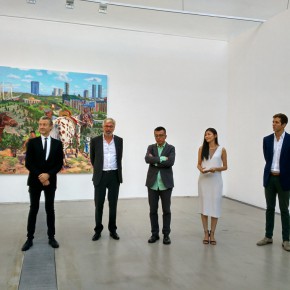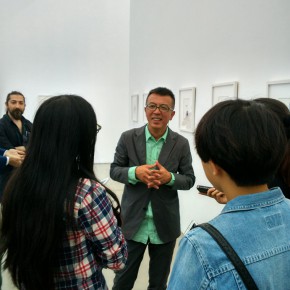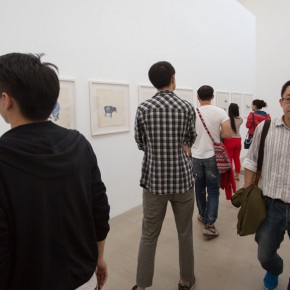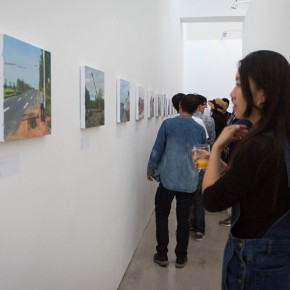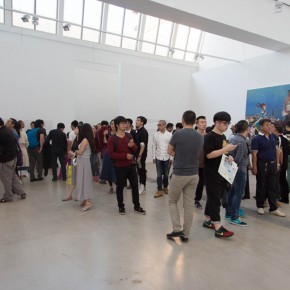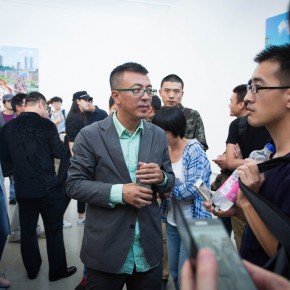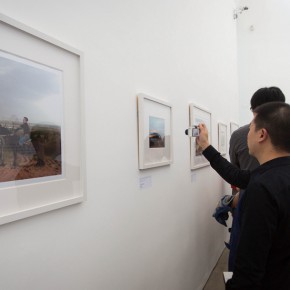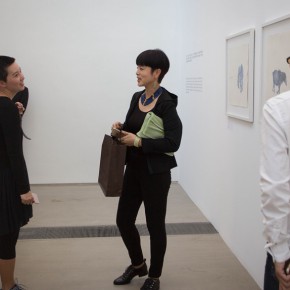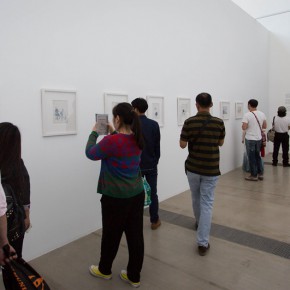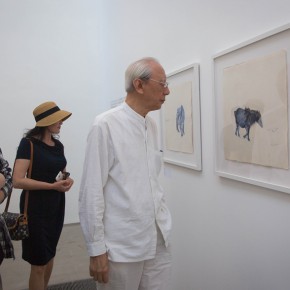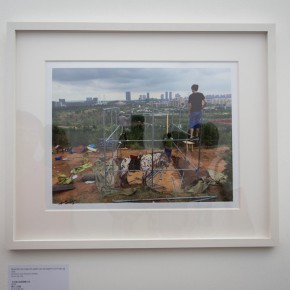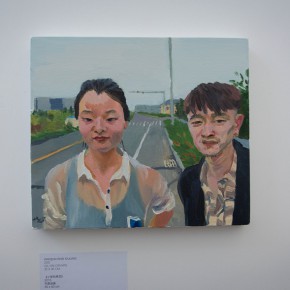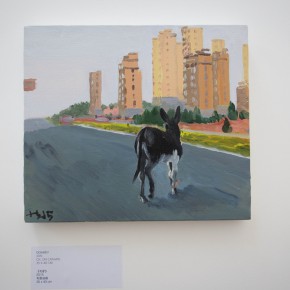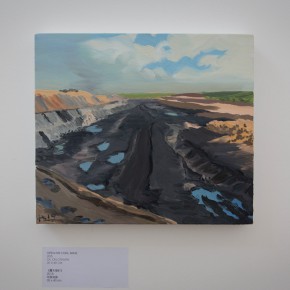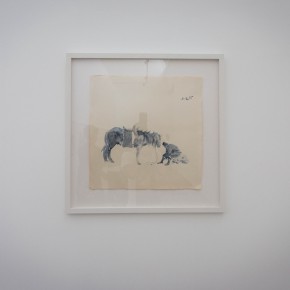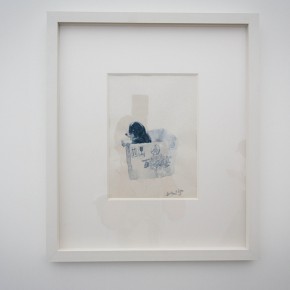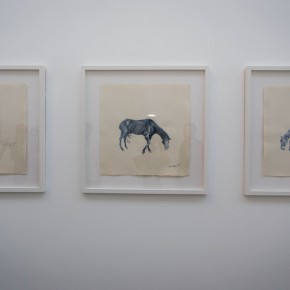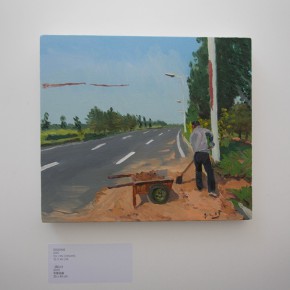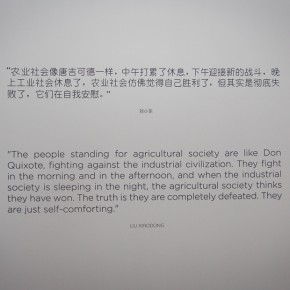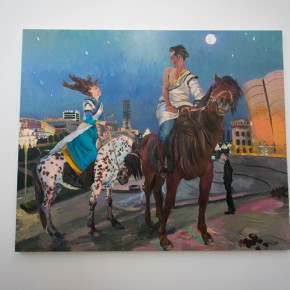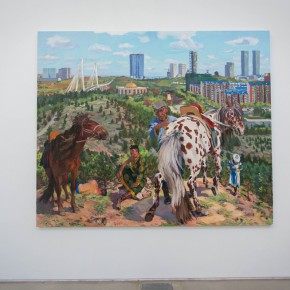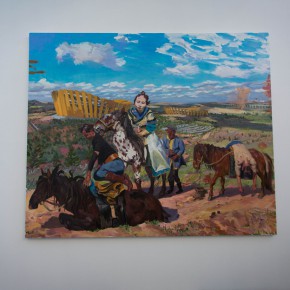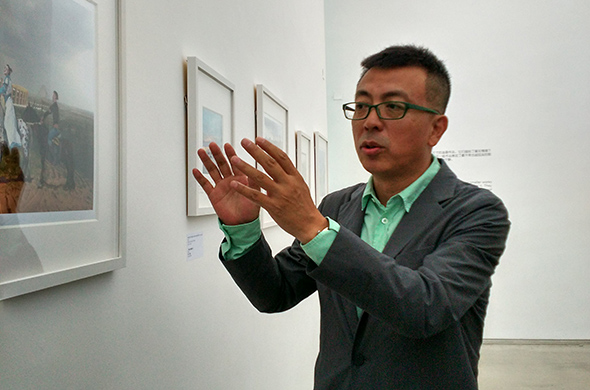
On the afternoon of Septemeber 12, curated by internationally renowned curator Jérôme Sans, Diary of an Empty City: Liu Xiaodong’s Solo Exhibition debuted at Faurschou Foundation Beijing. It is another solo exhibition for Liu Xiaodong after the acclaimed Liu Xiaodong survey exhibition entitled “Painting as shooting” was presented at the Cini Foundation for the Venice Biennale, it shows a series of work painted live on location during the summer of 2015 entitled “Diary of An Empty City”. Founder of the Faurschou Foundation Jens Faurschou, curator Jérôme Sans and artist Liu Xiaodong attended the opening ceremony.
Liu Xiaodong has chosen a propitious location in Ordos, Inner Mongolia to locate his latest scene for the live painting and reflection of the Chinese dream life and dream city environment. The exhibition is divided into 5 parts, first of all, the first exhibition hall presents three paintings which are the focus of Liu Xiaodong’s time in Ordos. In these works, the conflict between the traditional nomadic lifestyle of the Mongolian steppe and the modernisation as embodied by the ’ghost city’ of Ordos comes to life. The nomads are trying to reclaim the city that they have lost in the name of economic development. The process is by no means easy (the limp body hanging on the saddle of the horse in one painting attests to this), but in the end they are seemingly victorious. These large paintings fuse together the forms of Xiaodong’s imagination with present reality, creating tableaux in which the struggles of reconciling modernity with tradition take on new life. Liu Xiaodong said: “I have always felt there is a great friction between agricultural and industrial societies. Agricultural societies have been completely overwhelmed and in essence defeated by industrial civilization. I somehow enjoy agricultural society more. We make a huge sacrifice as a population to enjoy the convenience of the industrialization. The perfect example of this is here in Ordos, where the infrastructure has preceded the industrial movement with a city built 50 years ahead of its time. I believe that potentially in 50 years, it will become even more modern. However, during these 50 years, in this huge city with few people living in it, the cost of maintaining the city will be exorbitant. The changes we make in order to assume this industrial lifestyle and enjoy an industrial civilization are at a very high cost.”
The “Photo Paintings” showcase the unrealized original versions of the three large canvass Liu Xiaodong would paint, they display his original plans for each of the three scenes which would in the end change shape and become the finished oil paintings.
In juxtaposition with the three central canvases, the smaller works depict Ordos as it truly is and how Xiaodong experienced it. They reveal vignettes and scenes from the oftentimes-surreal environment of life in Ordos, capturing the tranquility and marks of humanity that remain in this “ghost city”. For these works, Liu Xiaodong told the media that, “These small paintings depict the real city scenes of today, for example, the street and the empty buildings around it. The small paintings act as a supplement to the big paintings. In the large paintings, everything was arranged according to my imagination. For example, the horses are now not allowed in the city, but I have them entering the city in the painting. So in the smaller sized paintings, I want to focus on a true depiction of the real settings and the absurd situations one finds in the city.” The artist through the “close-up” of landscape series to reflect the two different angles of reality - witness and imagination.
Liu Xiaodong’s “Blue” series of works on paper acts as a memorial to the lost traditions and lost societies displaced by the advent of modernity and industrialization. The blue figures painted on fragile handmade paper emulate the style and subject matter of traditional Chinese paintings, particularly in their portrayal of horses as a key subject matter. For this group of work, Liu Xiaodong said: “The paintings of ink and wash are about the relations between humans and horses.” In order to permanently perserve them, the artist uses acrylic instead of blue ink.
Accompanying the Diary of an Empty City is the documentary film K.O. directed which was filmed by Liu Xiaodong’s frequent collaborator Yang Bo. The film delves into the lives of 4 young ethnic Mongolians, in their disparate reactions to urbanization, one sees parables applicable to human responses to societies in flux the world over. In addition, Liu Xiaodong also wrote the lyrics for the film which is both the textual supplement for the paintings and the cohension of the whole exhibition.
Curator Jérôme Sans wrote in the preface: Ordos is situated in the center of a region, which has some of the largest deposits of coal in China, and has been transformed in record time from one of the poorest areas of China to one of the wealthiest. Local farmers and miners have become the protagonists of rags-to-riches stories as regional and city governments have built the dream city. Although it is a giant metropolis with amazing infrastructure including condominium towers, shopping malls, a museum and high-speed trains, Ordos remains a place mysteriously empty with a population of approximately 20,000 inhabitants. A city without residents – an unfinished plan, a paradoxical place where the realization of a modern dream society in terms of urban infrastructure lacks only the inhabitants to live their fulfilled dream life.
Liu Xiaodong investigates the ideal of the dream life within the context of the reality of the current Chinese lifestyle, discreetly asking, “What is our dream?” Could the Chinese common man’s search for his dream existence in some way be an unattainable mirage? Liu Xiaodong said: “Someone asked me if I prefer a bustling city or a ghost city. This is a difficult question to answer. I might still prefer the ghost city, because it is somehow a true luxury to enjoy such huge infrastructural resources without competing with other people. I personally think it must be a pleasure for local people to live here.
The exhibition continues to October 18.
About the artist
Liu Xiaodong (1963) lives and works in Beijing. He holds a BFA and an MFA in painting from the Central Academy of Fine Arts, Beijing (1988-1995). The artist gained recognition in the 1990s and represents the Chinese Neo-Realism style. His solo exhibitions include Kunsthaus Graz, Austria (2012) and Ullens Centre for Contemporary Art, Beijing (2010), while his work was also shown in various group exhibitions such as the Shanghai Biennale (2000, 2010), the 15th Biennale of Sydney (2006) and the 47th Venice Biennale (1997).
About the curator
Jérôme Sans is an internationally renowned curator, art critic, artistic director who has curated numerous major exhibitions around the world. He was the former director of the groundbreaking Ullens Centre for Contemporary Art in Beijing and co-founder of the acclaimed Palais de Tokyo in Paris. He is currently co-artistic director of one of the most important urban development projects in Europe, the Grand Paris Express and co-founder of Perfect Crossovers ltd, a Beijing based cultural consultancy group.
Courtesy of the artist and the Faurschou Foundation, text by Chen Peihua and edited by Sue/CAFA ART INFO, Photo by Yang Yanyuan and Chen Peihua/CAFA ART INFO.


